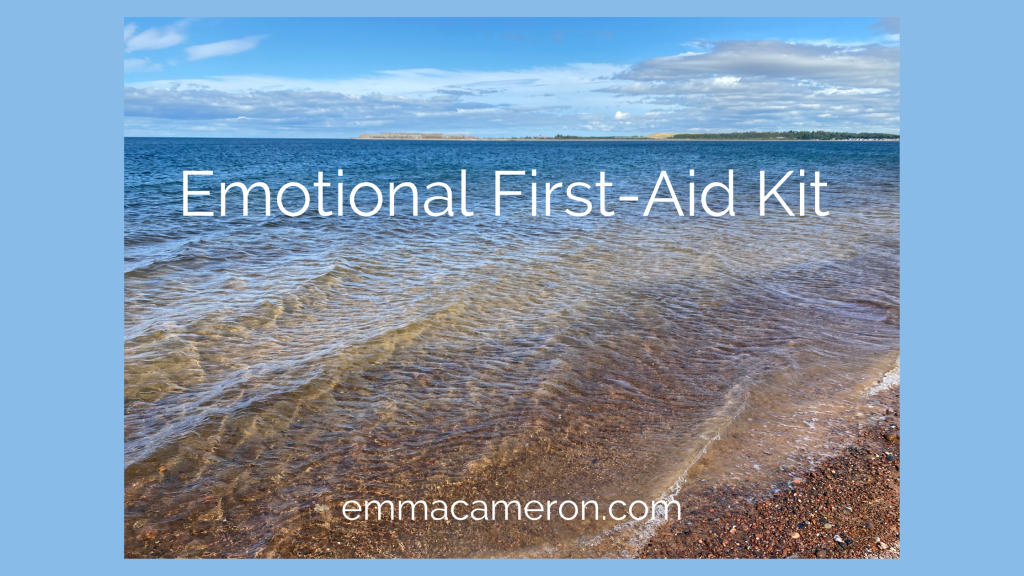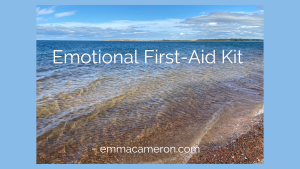
Life can sometimes leave us feeling completely thrown and needing an emotional first-aid kit. All kinds of things can feel destabilising: something going on with one of your kids or your partner; a health crisis; severe weather affecting your home or travel; something stressful coming up at work; or a bereavement or other loss. You may be affected by having to endure, day-to-day, harmful experiences of racism, homophobia, misogyny or anti-fat bias. Not to mention broader, global issues like the current climate emergency we are all in, and international crises including war.
When this all gets too much, your nervous system responds automatically. You might go into a hyper-alert state, perhaps first freezing, then feeling intense energy flooding your body as the fight-or-flight response kicks in. Fearful or blaming thoughts might arise, perhaps along with an urgent ‘I must fix this NOW!’
When the fight-or-flight energy can’t get you away or remove the problem, your body may go into a kind of shut-down slump. Your mind may feel like it’s gone elsewhere, and you may feel numb and flat, or like you’re shrinking or collapsing.
You need an emotional first-aid kit, fast! (And after that, of course, different kinds of responses and help may be needed).
Here are 22 things, backed by science, you can add to your ‘Emotional First Aid Kit’:
Breathe
This is always the first thing you should attend to from your emotional first-aid kit. First notice how you are breathing, then see if you can deepen and lengthen each breath. Aim to make your out-breaths particularly slow and long, pursing your lips as if you’re blowing bubbles through a drinking straw. You should find that your belly moves: this shows that your diaphragm is working as it needs to.
Hands on chest and belly
Place one hand on your chest. Then put the other on your belly. Breathe deeply and slowly. You could also do this whilst saying to yourself ‘comfort’ on the in-breath and ‘peace’ on the out-breath. Try to attune your awareness to how this physically feels in your chest and belly.
Move
Dancing, walking, running, or gently twisting your body and swinging your arms from side-to-side, can all be very helpful both in dispersing the anxious energy, and re-mobilising any flatness. Using each hand alternately to tap the opposite side of your body can also be re-stabilising.
Push against a wall
This is a good exercise to have in your emotional first-aid kit. Standing with one arm out sideways, lean lightly against any solid object (e.g., wall, lamp post), pressing into it with your hand. Breathe in slowly and smoothly while you push against the object. Then breathe out slowly and smoothly as you relax your arm. This emotional first-aid technique can be done in public spaces with no-one else thinking anything of it. You can also try a version of this sitting with your back against a wall, or the back of a bus seat etc. Again, breathe in as you push, breathe out as you relax. Repeat as many times as you want.
Connect face-to-face
Our nervous systems are built to respond strongly to facial expressions. If there is someone available who is able to connect with you in a warm and friendly way, face-to-face visual connection with them can be powerfully regulating. This particularly applies if the facial muscles around the mouth and eyes are moving, and you sense their empathy or friendly intentions. However, if their facial expression is neutral or perceived as negative, this is unlikely to help you feel calmer.
Soothe a pet
The kind, gentle tone of voice, and lilting style of speaking, that most of us intuitively use when speaking fondly to a beloved pet or baby, helps switch on the ‘ventral vagal’ branch of the autonomic nervous system. This means we’re eased into a more peaceful frame of mind. Stroking a pet can also help soothe our nervous system.
Attend to your feet and legs
Ask yourself how your feet and legs feel right now. Really allow time and space to consider the answers and notice any ongoing moment-to-moment changes in the sensations. This can rescue you from anxious over-thinking and panic modes. Wiggle your toes, and perhaps take off shoes and socks and feel the grass or the carpet.
Name your body sensations and emotions
Emotions aren’t just in the head! We feel them in a range of parts of the body, particularly the chest, throat and tummy areas. When you try to find words to closely match what you are feeling in your body, you are bringing different parts of your brain into connection. This has been shown to reduce feelings of overwhelm and anxiety.
“This too shall pass”
Remind yourself that whatever you are experiencing right now, will feel different with the passing of time.
Hum or sing
Humming and singing can be very effective in calming the nervous system, whether you do it alone or with others. Even humming under your breath can have a physiological effect. And singing in a group or choir with other people is even more powerful.
Chew gum
Apparently, when we chew, an ancient part of our brain is tricked into believing that everything’s okay, setting up a calming feedback loop.
Five senses grounding
When you feel particularly anxious and overwhelmed, take your attention into the here-and-now, and combine that with the logical, labelling, numbering part of your brain. Specifically look for, and name, 5 things you can see, 4 things you can hear, 3 things you can touch, 2 things you can smell, and 1 thing you can taste. To add to the challenge, you might try adding extra modifiers such as ‘5 red things’ or ‘5 things starting with B’. Check out my blog post ‘Ground Yourself‘.
Be warm
We tend to feel safer when we are warm (although not if we’re too hot). Warm clothes, a blanket or holding a hot drink, can all make a difference in your emotional first-aid kit, especially when combined with fresh clear air to breathe.
Add some gentle pressure
A weighted blanket, a prolonged hug, or even a self-hug can all have a place in your emotional first-aid kit and be calming to the body. Pressing a cushion or cuddly toy to your chest can also be effective.
Imagine your larger, wiser self comforting and holding your scared overwhelmed self
It can be easy to imagine, at times of overwhelm and crisis, that your fearful, worried, vulnerable self is all of who you are. But it can be possible to tap into a wiser, greater self too, who can be an enormous comfort to the scared part. (Ideally you’ll practise first when you are not feeling strung-out, so that it’s something you become more familiar with).
Basic self-care: eat, sleep, movement
I’m sure you know about these. But even though they’re well-known and might seem rather prosaic, it’s important to remember that they are very powerful. If sleep is hard to come by, or you keep waking in the night worrying, check out my blog posts about this.
Connect to nature
Being in nature – even if all you can manage is to spend a couple of minutes looking up into a tree in the street – will help calm you. Listen for birdsong or for the sound of the breeze rustling the leaves, and look out for patches of greenery or a flowing stream or river. Alternatively, you might like to try a tree visualisation.
Remember that it’s normal for life to have shocks and difficulties sometimes
Everybody has times when something unexpected and very difficult happens. Sometimes the event is life-changing; other times it’s just a bit of a pain to have to deal with. From a wider perspective, occasional trials and tribulations are (unfortunately) part of most people’s lives. Some things can be battled, whilst others just have to be experienced and accepted. Look to find a balance so you’re neither minimising the situation nor catastrophising it.
Allow space for all your feelings, preferably with someone alongside you
If you are now in a safe place, it might be helpful to see if you can make room for all your feelings. Having someone with you while you process your emotions can be enormously helpful, as long as they aren’t feeling panicked themselves. You may well be feeling more than one emotion at a time – this is quite normal. Core emotions tend to come in waves, and if you can allow them to pass through you, you’ll find you can get relief in between the intense waves, and process the feelings so they don’t get stuck in you. However, if you are currently in an immediate danger situation, it may be more helpful to only name your feelings without trying to fully feel them just yet.
Use music to re-set
Music is a powerful mood-changer. Listen to music that fills a need in you – whether that need is for upbeat lively cheer, calm tranquility, or angry thumping.
Reach out
Humans are wired to need to regularly connect with others. Make a plan to connect with other people at various times over the next few days. Even if you are an introvert by nature and need plenty of alone-time for regrouping and restoration, it’s rarely helpful to shut yourself away for an entire day or longer, especially if you are experiencing emotional stress.
Join together and work for change
Your emotional overwhelm may be not just personal but also linked to a broader, systemic issue, such as the climate crisis, racism, or lack of employment rights. Consider joining with other people who share your values. Working together to fight for an important cause can be valuable on many levels, and give you a sense of empowerment and hope.
After the first-aid, then what?
I hope these emotional first-aid kit suggestions are helpful to you. They may be enough to settle you, along with the support of your family, friends and community; but if the issue keeps recurring you might do well to address things in more psychological depth. If accepting and allowing yourself to experience your emotions feels too challenging or even impossible, do consider seeing a therapist. Psychotherapy and counselling can make a huge difference. Sometimes trauma focused therapy will be the most helpful (read my blog post ‘Trauma therapy has changed – here’s how’). Although therapy won’t stop all of life’s bad stuff happening, it can certainly help you be more resilient and able to manage your feelings and responses.
